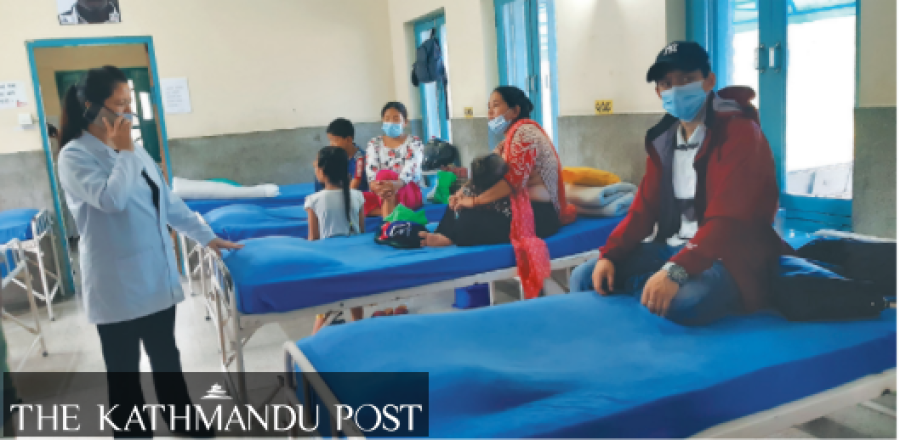Gandaki Province
Treatable eye disease is causing blindness among children in Gandaki districts
500 cases of Seasonal Hyperacute Panuveitis caused by Gazaline moths have been reported in Gandaki Province in past year.
Lal Prasad Sharma, Ghanshyam Khadka & Agandhar Tiwari
Cases of Seasonal Hyperacute Panuveitis, primarily caused by the Gazaline moths, among children are rising in several districts of Gandaki Province. The disease, if untreated, can leave patients blind, say ophthalmologists.
According to ophthalmologists, there are various factors that cause Seasonal Hyperacute Panuveitis (SHAPU) but one of the leading causes is physical contact with the Gazaline moth. When the dust on the scales of the moth comes in contact with the eyes, it causes damage to the retina and the pupil, says Dr Madan Prasad Upadhyay.
The disease is prevalent in Gandaki Province and was first found in the province by Upadhyay in Lamachaur, Pokhara, in 1975.
Amrit Pun, 18, of Benibazaar in Myagdi district complained of irritation in his left eye in the last week of August. He started complaining of discomfort after he had come in contact with a Gazaline moth. He visited Beni Hospital on August 29 for treatment after his condition worsened.
The hospital immediately referred him to Pokhara-based Himalaya Eye Hospital. But by the time he reached Pokhara, he had lost his eyesight.
“The retina of Amrit’s left eye was completely damaged when he arrived at the hospital,” said Prakriti Dhungana, a technician at the Eye Treatment Unit of Beni Hospital. “There was a long delay in treatment, which led to him losing his eyesight.”
Seven-year-old Bishesh Gautam of Hemja in Pokhara was playing in his house on Monday when he complained of soreness in his right eye. His eye had turned red and a scar marked the pupil, according to his father, Shiva Gautam.
“We immediately took him to the Himalaya Eye Hospital. The doctors at the hospital said that he was suffering from SHAPU. He is undergoing treatment at the hospital,” said Shiva. “I had noticed some moths in the house a couple of days ago. The doctors say they could be the reason for my son’s eye problem.”
Dinesh Pun, aged 7, of Tarakhola Rural Municipality-5 in Baglung has also been receiving treatment at Himalaya Eye Hospital for the past five days after SHAPU was diagnosed in one of his eyes. He underwent surgery twice.
“His eye condition is gradually improving now,” said his father, Omkar Pun.
As many as 34 patients, including 20 from Kaski, of SHAPU have visited Himalaya Eye Hospital in the past month. The number of SHAPU patients could be even higher as some patients may have not come to Pokhara for treatment, said the hospital.
According to Upadhyay, around 70 percent of SHAPU cases are caused by the Gazaline moths.
“One should protect themselves from the disease by controlling the Gazaline moths. Two SHAPU cases were found to be caused by other species of butterfly recently. But the disease is mainly caused by the moths,” said Upadhyay. “Studies are being conducted to find out the other causes of the disease.”
SHAPU is a disease seen and reported only in Nepal. It is known to cause blindness in children within a week of showing symptoms. The disease is mostly reported between the end of the monsoon season (August –September) and the peak of winter (December-January) in Nepal.
Around 1,500 cases of SHAPU caused by Gazaline moths have been reported in Gandaki Province in the past year, according to the Gandaki Health Directorate.
“We recently received 15 cases of SHAPU caused by Gazaline moths. The disease is treatable but only with timely medical intervention. It is therefore important to raise awareness among the general public about this disease and its causes,” said Dr Iliya Shrestha, medical director at Himalaya Eye Hospital.
According to Shrestha, SHAPU cases, which were reported only in Gandaki Province in the past, are being reported in Bhairahawa and Gulmi districts as well.
Until Wednesday, 34 cases of SHAPU were reported in Himalaya Eye Hospital alone. Among them, 15 patients needed hospital admission for treatment, doctors said.
According to the hospital administration, mostly children between five and 15 years of age are found affected by Seasonal Hyperacute Panuveitis.
“The initial signs of SHAPU are redness and decreased vision in one eye. The pupil of the affected eye gradually turns white. If left untreated, the patient could go blind within 48 hours,” said Shrestha.
According to Khim Bahadur Khadka, provincial health directorate of Gandaki Province, the number of patients suffering from SHAPU and illnesses caused by the Gazaline moths has increased in the province.
“We have started to raise awareness on the disease at the community level,” Khadka said.
Meanwhile, the ultrasound machine at the Himalaya Eye Hospital is old and goes out of order time and again, health workers say.
“It is necessary to conduct ultrasound of the eyes to treat the patients. But the machine does not work properly. This has caused difficulty in the treatment process,” said Shrestha of the Himalaya Eye Hospital. “The hospital administration has demanded Rs 4 million from the concerned authorities to purchase a new machine.”
In Myagdi, over 10 cases caused by the Gazaline moths have been reported since August 29.
Dinesh Baniya, officer at the Netra Jyoti Sangh in Myagdi, said, “We referred four patients to Pokhara after moth scales were found lodged deep inside their eyes. Two other patients are receiving treatment here.”
In Parbat, diseases caused by the Gazaline moths have been rising in Kushma and other rural areas since the last week of August.
According to Parbat Hospital, three patients are receiving treatment at the health facility for illnesses caused by the scales of the Gazaline moth.
“We found microscopic scales of Gazaline moths embedded inside the eyes of the patients. The patients have reported coming in contact with the moths,” said Sumitra Adhikari, a health worker at Lions Eye Treatment Centre.




 10.12°C Kathmandu
10.12°C Kathmandu.jpg)
.jpg)
.jpg)










